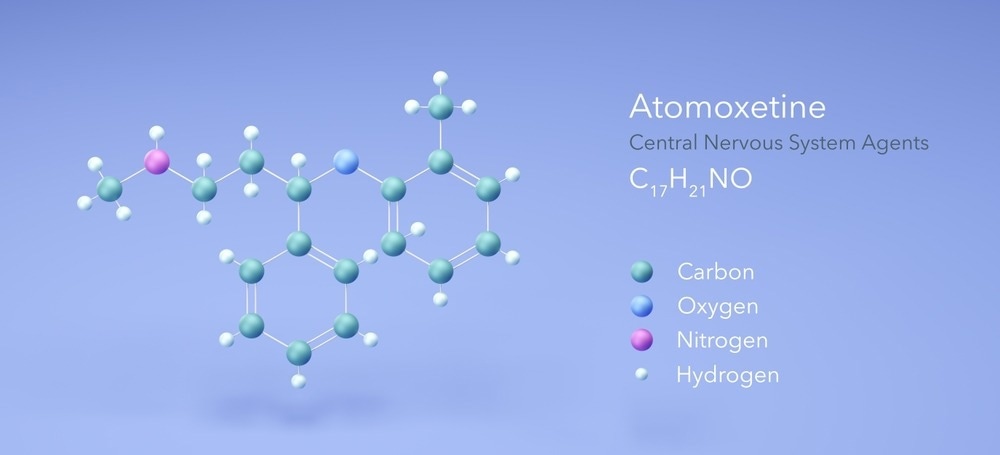What are non-stimulant medications for ADHD?
How do non-stimulant medications work?
When are non-stimulant medications prescribed?
Comparing efficacy: Non-stimulants vs. stimulants for ADHD
Side effects and safety profile of non-stimulant medications
Considerations for healthcare providers and patients
References
Further reading
Attention deficit hyperactivity disorder (ADHD) is a neurodevelopmental disorder that affects someone’s attention, hyperactivity, impulsivity, and more.1 This happens because of executive functioning differences, meaning that the brain is regulated and functions differently to those without ADHD.2

Image Credit: VectorMine/Shutterstock.com
ADHD can be managed through many different methods, including therapy and medication. ADHD medication may be either a stimulant or a non-stimulant. Both types work by affecting the brain’s chemistry to normalize levels of alertness (or “arousal”).3 While stimulant medications work for many people, others may wish to try non-stimulant medications.2,4
What are non-stimulant medications for ADHD?
Non-stimulant medications can be used to manage ADHD either alongside or instead of stimulant medications.2,5 They are generally classified as either Alpha-2 adrenergic agonists or Selective Norepinephrine Reuptake Inhibitors (SNRI).1,6
Examples of branded non-stimulant ADHD medications include:
- Strattera
- Intuniv
- Qelbree
- Kapvay
These medications are clinically atomoxetine hydrochloride, guanfacine hydrochloride, viloxazine, and clonidine hydrochloride, respectively.

Atomoxetine molecule. Image Credit: SergeiShimanovich/Shutterstock.com
As with other conditions, medication may be prescribed for ADHD on or off-label.7 On-label medications are specifically approved for that condition, while off-label medications are approved for other conditions but work for similar symptoms or characteristics.7
Antidepressants may also sometimes be used to manage ADHD.8 This includes bupropion hydrochloride, a norepinephrine-dopamine reuptake inhibitor, and tricyclic antidepressants like desipramine hydrochloride and imipramine hydrochloride.4,8
How do non-stimulant medications work?
Non-stimulant ADHD medications of different classifications work in different ways. Both Alpha-2 adrenergic agonists and SNRIs affect norepinephrine (or noradrenaline) levels in the nervous system, but they do so through distinct means.1,6 Norepinephrine, and the wider system it belongs to, can be involved in the regulation of processes like memory and alertness, meaning it can play a role in the presentation of ADHD.9
Atomoxetine and viloxazine are both SNRIs, while guanfacine and clonidine are Alpha-2 adrenergic agonists. Alpha-2 adrenergic agonists affect the central nervous system. They create a negative feedback loop that decreases the production of catecholamine and norepinephrine, which in turn may decrease ADHD symptoms.1,10
SNRIs also target norepinephrine transmission to manage ADHD.11 They work by stimulating receptors in synaptic cells in the central nervous system by blocking norepinephrine and serotonin from being reuptaken.11
When are non-stimulant medications prescribed?
Non-stimulant medications may be prescribed for ADHD alongside or instead of stimulant medications.1,5 They are generally used as a second-line treatment, meaning that stimulants are normally tried first.2
A study published in 2021 investigated the responsiveness and side effects of stimulant ADHD medication among adults over 55 years.12 Of their sample, 42% of patients stopped using their medication due to either side effects or a lack of response from the medication, although 65% of patients also reported a positive response.12 If this number is reflective of wider populations, it shows that there is a need for alternative medications.12
Challenges in the Global ADHD Medication Supply Chain
Combined medication may be used in some cases, where stimulants and non-stimulants are prescribed together as a part of a treatment plan.5 Another paper published in 2021 studied the efficiency of combined medication on adults and children with ADHD.5 Notably, combined medication was adhered to for longer than in patients who were only prescribed one type of ADHD medication.5
If non-stimulants are prescribed alone, it may be because someone has had unpleasant side effects from stimulant medication.1,6 Stimulant medications also may be less safe to use if the patient has any contraindications, like underlying health conditions or other medications that interact with them.6
Comparing efficacy: Non-stimulants vs. stimulants for ADHD
Stimulant medications are an effective way of managing ADHD, but non-stimulant medications can be also.6 If someone has a negative experience with using stimulants, then non-stimulant medications could be a suitable alternative.6
Some stimulant and non-stimulant medications can be equally effective to one another in some regards. For example, the non-stimulant atomoxetine and stimulant methylphenidate are comparable in how much they can improve cognition when treating ADHD.2
A systematic review researched the effects that stimulant and non-stimulant medications have across five areas of cognition: inhibition, attention, reaction time, and working memory.2 Methylphenidate improved all areas of cognition.2 Atomoxetine also improved all areas except for working memory.2 Despite this, the effects that were found with atomoxetine were superior to the effects found for methylphenidate.2
Non-stimulant medications can take longer to reach effectiveness, meaning it takes longer for the person using them to feel the benefit.13 This can mean that more time is needed to titrate medications.13 Titration happens when doses are adjusted to find what suits the user based on how effective they are at their peak.14 However, the duration of action can be longer, meaning the effects can last longer than with stimulants.13
Side effects and safety profile of non-stimulant medications
Despite their safety, both stimulant and non-stimulant medications alike can have side effects and considerations that should be kept in mind. SNRIs can lead to toxicity, which can present with issues like tachycardia (increased heart rate), hypertension, consciousness issues, and more. This is quite rare, however, and is thought to happen mostly in the case of an overdose.6,15
Venlafaxine and duloxetine, which are both SNRIs, have a high therapeutic-to-toxicity ratio.15 Moreover, several studies also note that venlafaxine does not appear to have a relationship with heart rate or blood pressure, or other cardiovascular side effects.6 Overdoses are still possible – and can happen accidentally – meaning they must be administered carefully, but they are generally considered safe.6,15
Alpha-2 agonists also raise some safety concerns, primarily due to a lack of research.1 Little is known yet about the long-term adverse effects the medication may have, including their cardiovascular effects.1 Further research into the use of these medications, particularly with ADHD in mind, would help to address this.1
Considerations for healthcare providers and patients
Non-stimulant medication may be a viable option for some individuals, either instead of or in addition to stimulants.2,5 Cases should be considered on an individual basis depending on what their goals for treatment and if they have any issues with other medications.4,16
Medical intervention is important if someone is experiencing adverse side effects.16 Healthcare providers can help to make sure the patient is receiving the best, safest care they can, including looking into appropriate medication regimes. Some side effects can also be monitored if need be, such as heart rate and blood pressure.17,18
The research suggests that using combined medication may lead to more adherence, and so this may be something for providers and patients to consider.4,5,12 Considering the relatively small sample sizes used in some studies, though, more research needs to be conducted to make sure that these findings are representative of most people.4,5,12
References
- Neuchat, E. E., Bocklud, B. E., Kingsley, K., Barham, W. T., Luther, P. M., Ahmadzadeh, S., ... & Kaye, A. D. (2023). The role of alpha-2 agonists for attention deficit hyperactivity disorder in children: a review. Neurology International, 15(2), 697-707. https://pubmed.ncbi.nlm.nih.gov/37218982/
- Isfandnia, F., El Masri, S., Radua, J., & Rubia, K. (2024). The Effects of Chronic Administration of Stimulant and Non-stimulant Medications on Executive Functions in ADHD: A Systematic Review and Meta-Analysis. Neuroscience & Biobehavioral Reviews, 105703. https://pubmed.ncbi.nlm.nih.gov/38718988/
- Idrees, I., Bellato, A., Cortese, S., & Groom, M. J. (2023). The effects of stimulant and non-stimulant medications on the autonomic nervous system (ANS) functioning in people with ADHD: A systematic review and meta-analysis. Neuroscience & Biobehavioral Reviews, 144, 104968. https://www.sciencedirect.com/science/article/pii/S0149763422004572
- Brancati, G. E., Magnesa, A., Acierno, D., Carli, M., De Rosa, U., Froli, A., ... & Perugi, G. (2024). Current nonstimulant medications for adults with attention-deficit/hyperactivity disorder. Expert Review of Neurotherapeutics, 24(8), 743-759. https://pubmed.ncbi.nlm.nih.gov/38915262/
- Bahn, G. H., & Seo, K. (2021). Combined Medication with Stimulants and Non-stimulants for Attention-deficit/hyperactivity Disorder. Clinical Psychopharmacology and Neuroscience, 19(4), 705. https://pubmed.ncbi.nlm.nih.gov/34690125/
- Dezfouli, R. A., Hosseinpour, A., Ketabforoush, S., & Daneshzad, E. (2024). Efficacy, safety, and tolerability of serotonin-norepinephrine reuptake inhibitors in controlling ADHD symptoms: a systematic review and meta-analysis. Middle East Current Psychiatry, 31(1), 8. https://mecp.springeropen.com/articles/10.1186/s43045-024-00400-1
- Carton, L., Dondaine, T., Deheul, S., Marquie, C., Brigadeau, F., Amad, A., ... & Menard, O. (2018). Supervised off-label prescribing of methylphenidate in adult ADHD. L'encephale, 45(1), 74-81. https://pubmed.ncbi.nlm.nih.gov/30122296/
- Nazarova, V. A., Sokolov, A. V., Chubarev, V. N., Tarasov, V. V., & Schiöth, H. B. (2022). Treatment of ADHD: Drugs, psychological therapies, devices, complementary and alternative methods as well as the trends in clinical trials. Frontiers in pharmacology, 13, 1066988. https://pubmed.ncbi.nlm.nih.gov/36467081/
- Vanicek, T., Spies, M., Rami-Mark, C., Savli, M., Höflich, A., Kranz, G. S., ... & Lanzenberger, R. (2014). The norepinephrine transporter in attention-deficit/hyperactivity disorder investigated with positron emission tomography. JAMA psychiatry, 71(12), 1340-1349. https://jamanetwork.com/journals/jamapsychiatry/fullarticle/1917887
- Norman, Kenneth, and Thomas M. Nappe. "Alpha receptor agonist toxicity." StatPearls. StatPearls Publishing, 2023.
- Sheffler, Patel, and Sara Abdijadid. "Antidepressants." StatPearls. StatPearls Publishing, 2023.
- Michielsen, M., Kleef, D., Bijlenga, D., Zwennes, C., Dijkhuizen, K., Smulders, J., ... & Kooij, J. S. (2021). Response and side effects using stimulant medication in older adults with ADHD: an observational archive study. Journal of Attention Disorders, 25(12), 1712-1719. https://pubmed.ncbi.nlm.nih.gov/32508213/
- Kolar, D., Keller, A., Golfinopoulos, M., Cumyn, L., Syer, C., & Hechtman, L. (2008). Treatment of adults with attention-deficit/hyperactivity disorder. Neuropsychiatric disease and treatment, 4(1), 107-121. https://pmc.ncbi.nlm.nih.gov/articles/PMC2518387/
- Caffrey, A. R., & Borrelli, E. P. (2020). The art and science of drug titration. Therapeutic Advances in Drug Safety, 11, 2042098620958910. https://pubmed.ncbi.nlm.nih.gov/33796256/
- Alibegović, A., Kariž, S., & Volavšek, M. (2019). Fatal overdose with a combination of SNRIs venlafaxine and duloxetine. Forensic Science, Medicine and Pathology, 15, 258-261. https://pubmed.ncbi.nlm.nih.gov/30796754/
- Coghill, D. (2012). Non-stimulant drug treatments for adults with ADHD. ADHD in adults: A practical guide to evaluation and management, 89-117.
- Cardiovascular Effects of Stimulant and Non-Stimulant Medication for Children and Adolescents with ADHD: A Systematic Review and Meta-Analysis of Trials of Methylphenidate, Amphetamines and Atomoxetine
- Chaplin, S. (2018). Attention deficit hyperactivity disorder: diagnosis and management. Progress in Neurology and Psychiatry, 22(3), 27-29. https://onlinelibrary.wiley.com/doi/10.1002/pnp.511
Further Reading
Last Updated: Oct 31, 2024